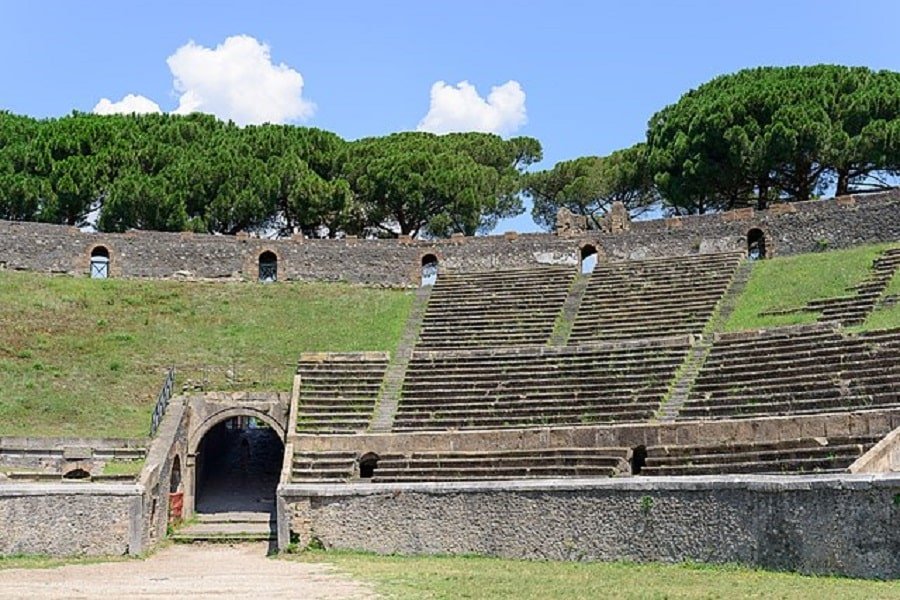A Roman vomitorium might suggest some obscure room that allowed the Romans to get rid of their stomach content. However, a vomitorium was in no way related to vomiting. In fact, it was a common part of every amphitheater and Colosseum: it refers to the corridors that helped to ‘spit out’ the immense crowds which gathered in the places for entertainment.
Still, how come the word vomitorium is so misunderstood? And did Romans actually vomit there?
Table of Contents
What is a Vomitorium?

A vomitorium was simply the passage that spectators used to easily reach their seats in the Colosseum or theatre. Although the word vomitorium might indicate that we’re talking about a room to vomit, it actually wasn’t. Over time, the word became increasingly misused to refer to a room used for vomiting. But, not to worry: vomiting Romans are no myth. It was actually part of the Roman lifestyle.
Why is It Called Vomitorium?
The word vomitorium, or plural vomitoria, comes from the Latin root vomere. The definition of vomere is ‘to vomit’ or ‘to spew forth’. So sure, it is still related to vomiting, but not in a personal sense. The corridor was named vomitorium because it ‘spat out’ all the spectators that came to the Colosseum or amphitheater efficiently.
As you might know, the Colosseum and other places for entertainment were usually quite big. They hosted very large crowds, up to 150.000 people. The vomitorium would be big enough to rapidly discharge large audiences. That’s both necessary in case of emergency and convenient when another show is planned straight after.

How Efficient Was a Vomitorium?
Because of the vomitorium, scientists believe that the theatre and stadiums could be filled in under 15 minutes. While the vomitoria aren’t very prevalent in Roman literature, the Roman writer Macrobius wrote about the amphitheater passageways that could ‘disgorge’ the audience to and from their seats.
Still, the general lack of actual descriptions of a Roman amphitheater spewing out people with the use of a vomitorium might be part of the eventual confusion about the concept.
The Vomitorium and Eating Habits of the Romans
So, the construction and use of a vomitorium itself don’t really tell anything about the eating and vomiting habits of the ancient Romans. However, there is a reason that the two get confused. The vomiting habits of the Romans were very real and disgusting.
A prominent Roman philosopher, Seneca, wrote about it in multiple instances. Seneca lived in the first century AD and wrote about slaves cleaning up the vomit of drunks in the dining room, mostly during banquets.
In a letter to Hevlia, he mentioned the vomiting again and claimed that ‘they vomit so they may eat, and eat so that they may vomit’. Another ancient source said that Gaius Julius Caesar was known to leave the diner area to vomit. So you’re right, bulimia was apparently already a thing in ancient Rome, epitomized by stories of (mainly) imperial excess.

Room for Vomiting
Still, it is true that Julius Caesar would leave the dining room and vomit somewhere else. So, there was a specific room adjacent to the dining room where Julius Caesar would go to vomit? Nope.
The wrong idea that throwing up was a common practice, combined with the fact there was something called a vomitorium, made historians believe that the two were related. However, they weren’t, and such a room probably never existed. While today we prefer to vomit in the toilet or at least a sink, even the Roman emperors probably just vomited on the ground.
READ MORE: Who Invented the Toilet? The History of Flush Toilets
It’s not hard to imagine that historians would interpret a vomitorium to be an actual room for vomiting. And that’s exactly what happened. Based on the structure of the word (or, etymology), some historians assumed that a vomitorium was a room for upper-class Romans to vomit.

Reasons for Confusion
The combination of a vomiting habit and something called a vomitorium explains where the confusion surrounding the word is rooted. However, there is a deeper layer to the confusion. It can be traced back to a couple of things.
A large part of the misunderstanding comes from the lack of actual descriptions of an amphitheater ‘spewing forth’ people through the use of a vomitorium. It was just a common practice and aspect of Roman architecture, not really something to elaborately write essays about.
Besides that, it also has to do with language use. Up until the Victorian period (which started in 1837), the adjective vomitorius, -a, um was also used to describe emetics: puking as a result of food poisoning. So on the one hand the word was used for a corridor, on the other hand, it was used as a form of medical treatment for food poisoning.
It was to be expected that this could lead to confusion over time. And it did. After two thousand years, several publications would join the two together; claiming the Romans had a room to vomit, instead of it being a word for the vomiting itself and for the structure that let ‘something’ out.
The Sources of Misunderstanding
So what were the most prominent sources that caused the misconception surrounding vomitoria? It largely comes from writers in the Victorian period, amongst others Aldous Huxley and his comic novel ‘Antic Hay’.
The 1923 novel ‘Antic Hay’ elaborates on a vomitorium in a way that it is, indeed, a room adjacent to the dining room where the ancient Romans would come to vomit. Specifically, he says the following:
‘But Mr. Mercaptan was to have no tranquillity this afternoon. The door of his sacred boudoir was thrown rudely open, and there strode in, like a Goth into the elegant marble vomitorium of Petronius Arbiter, a haggard and dishevelled person…’

Misunderstanding before Aldous Huxley
Still, at the time Huxley’s book was published, there were already quite some articles that misinterpreted the vomitorium as essential to the Roman feasts.
For example, in two articles in 1871, a French journalist described the Christmas meal in England as ‘a gross, pagan, monstrous orgie – a Roman feast, in which the vomitorium is not wanting’.
A discussion on the culinary habits of the Brits is a story for another day, but it indicates that the confusion surrounding a vomitorium already started in the late 19th century.
This, too, was evident in another publication In that very same year. The English writer Augustus Hare published a book called Walks in Rome which, surprisingly, elaborated on the Roman lifestyle. Several times he mentioned a room adjacent to the dining room that was used for vomiting. According to Hare, it was ‘a disgusting memorial to Roman life’.
However, the claim that such a room existed at any Roman dinner party didn’t hold its ground for long. A criticism by an anonymous person stated that amateurs shouldn’t deal with a technical subject like Roman archaeology.
And, he is definitely right. It only leads to misinterpretation and confusion, as would be evident by now. While the criticism would suppress the confusion about the vomitorium for some time, the popular notion of a vomiting room was eventually adopted anyway.

Misunderstanding after Huxley
Another important factor in the misunderstanding of the concept comes from the Los Angeles Times. They published two articles in 1927 and 1928, a couple of years after Huxley published his book. They mentioned a vomitorium. The narrative was that the elite and academics would go to the vomitorium to ‘free themselves for more.’
While a book has quite the reach, a newspaper probably has a wider reach. The publications by the Los Angeles Times should therefore be regarded as essential to the misconception of the word vomitorium.